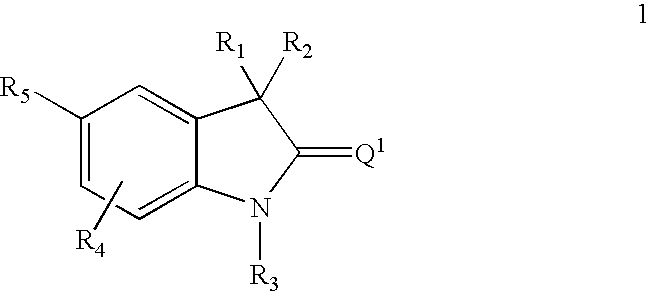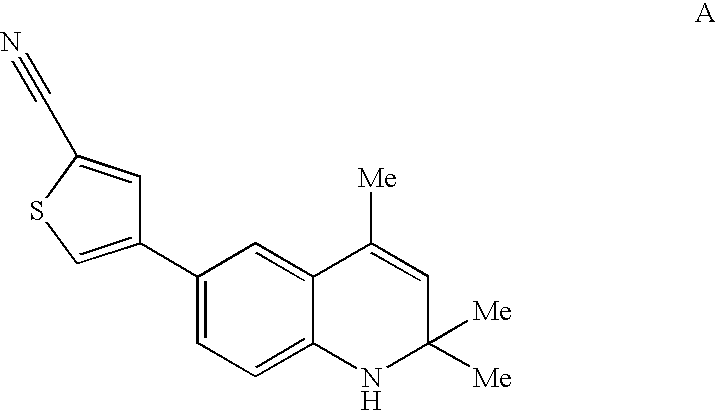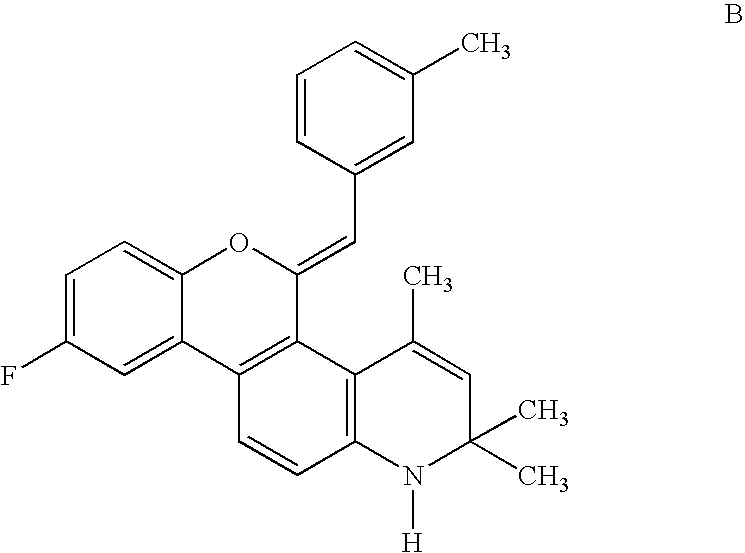Thio-oxindole derivatives
a technology of thio-oxindole and derivatives, applied in the field of compounds, can solve problems such as increasing the risk of uterine cancer
- Summary
- Abstract
- Description
- Claims
- Application Information
AI Technical Summary
Benefits of technology
Problems solved by technology
Method used
Image
Examples
example 1
5′-(3-chlorophenyl)spiro[cyclohexane-1,3′-[3H]indole]-2′(1′H)-thione
Spiro[cyclohexane-1,3′-[3H]indol]-2′-(1′H)one
[0198] A solution of oxindole (25 g, 0.19 mol) in anhydrous tetrahydrofuran (800 cm3) was cooled to −20° C., then n-butyllithium (2.5M in hexanes, 152 cm3, 0.38 mol) was added slowly followed by N,N,N′,N′-tetramethylethylenediamine (51 cm3, 0.38 mol). After 15 min. 1,5-diiodopentane (174 g, 0.54 mol) was added slowly and the mixture was allowed to warm to room temperature. After stirring for 16 h. saturated aqueous ammonium chloride solution (1 L) and EtOAc (1 L) were added. After 15 min., the layers were separated and the aqueous phase was extracted with EtOAc (×2). The combined organic layers were extracted with hydrochloric acid (1N), then washed with brine (500 cm3), dried (MgSO4), and concentrated to obtain an oil. The oil was triturated with hexane (200 cm3) and benzene (20 cm3). The precipitate was collected and dried in vacuo to obtain the subtitled compound (26...
example 2
3-(1′,2′-dihydro-2′-thioxospiro[cyclohexane-1,3′-[3H]indol]-5′-yl)benzonitrile
[0202] To a solution of 5′-bromospiro[cyclohexane-1,3′-[3H]indol]-2′(1′H)-one (1.00 g, 3.57 mmol) in dimethoxyethane (20 cm3) was added tetrakis(triphenylphosphine)palladium (0.20 g, 0.17 mmol). After 15 min. 3-formylphenylboronic acid (1.00 g, 6.93 g) was added followed by potassium carbonate (2.90 g, 21 mmol) in water (10 cm3). After 20 h at reflux, the mixture was cooled poured into water and extracted with EtOAc (×3). The combined organic extract was washed with saturated brine, dried (MgSO4) and evaporated. The residue was purified by column chromatography (SiO2, EtOAc:hexane, gradient elution) to afford the title compound (0.66 g, 2.15 mmol, 60%) as a white solid, 1H NMR (CDCl3) δ 1.65-1.85 (m, 6H), 1.86-2.08 (m, 4H), 7.22 (d, 1H, J=8 Hz), 7.48 (dd, 1H, J=8, 2 Hz), 7.61 (t, 1H, J=8 Hz), 7.66 (d, 1H, J=2 Hz), 7.81-7.88 (m, 2H), 8.06 (t, 1H, J=2 Hz), 8.30 (s, 1H, br); MS ((+)ESI) m / z 306 (M+H)+.
3-(1′...
example 3
4-(1′,2′-dihydro-2′-thioxospiro[cyclohexane-1,3′-[3H]indol]-5′-yl)-2-thiophenecarbonitrile
3-(Trimethylstannyl)-2-thiophenecarbonitrile
[0206] A solution of 3-bromo-2-thiophenecarbonitrile (0.8 g, 4.3 mmol), tetrakis(triphenylphosphine)palladium(0) (0.25 g, 0.2 mmol) and hexamethylditin (1.4 g, 4.3 mmol) in dimethoxyethane (5 cm3) was heated under reflux for 14 h then cooled to RT. The reaction mixture was absorbed onto florisil and purified by column chromatography (SiO2, methylene chloride: hexane 1:9) to afford the subtitled compound (1.04 g, 3.8 mmol, 90%) as a clear viscous oil: 1H NMR (CDCl3) δ 0.35 (s, 9H), 7.56 (d, J=0.9 Hz, 1H), 7.66 (d, J=0.9 Hz, 1H).
4-(1,2-Dihydro-2-oxospiro[cyclohexane-1,3-[3H]indol]-5-yl)-2-thiophenecarbonitrile
[0207] A solution of the 5′-bromospiro[cyclohexane-1,3′-[3H]indol]-2′(1′H)-one (0.53 g, 1.9 mmol), dichlorobis(triphenylphosphine)palladium(II) (0.1 g, 0.14 mmol) and triphenylarsine (0.14 g, 0.47 mmol) in dimethoxyethane (8 cm3) was stirred und...
PUM
 Login to View More
Login to View More Abstract
Description
Claims
Application Information
 Login to View More
Login to View More - R&D
- Intellectual Property
- Life Sciences
- Materials
- Tech Scout
- Unparalleled Data Quality
- Higher Quality Content
- 60% Fewer Hallucinations
Browse by: Latest US Patents, China's latest patents, Technical Efficacy Thesaurus, Application Domain, Technology Topic, Popular Technical Reports.
© 2025 PatSnap. All rights reserved.Legal|Privacy policy|Modern Slavery Act Transparency Statement|Sitemap|About US| Contact US: help@patsnap.com



